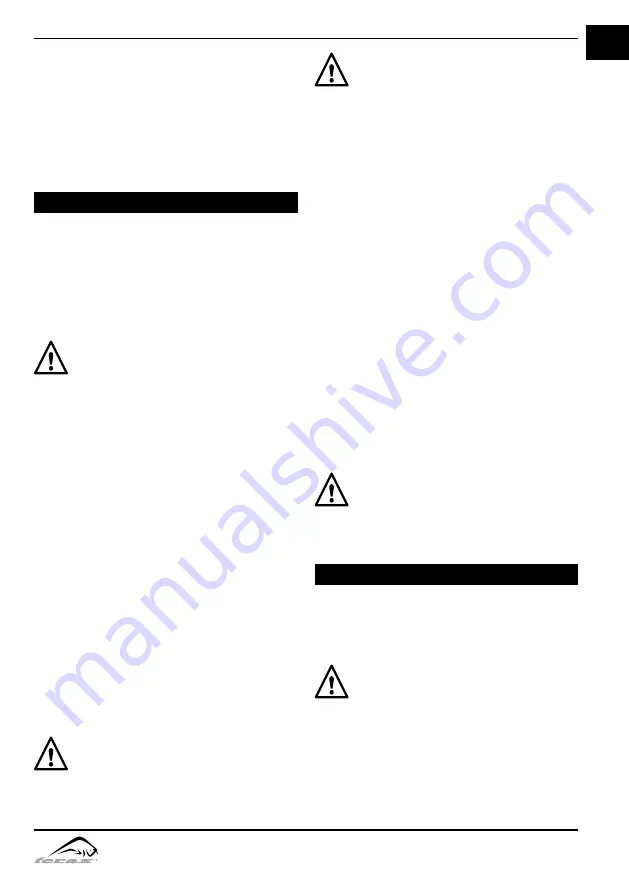
GB
11
bar touches an object, or when wood closes in and
pinches the saw chain in the cut. Tip contact in some
cases may cause a lightning-fast reverse reaction,
kicking the guide bar up and back toward the operator.
Pinching the saw chain along the bottom of the guide
bar may pull the saw forward, away from the operator.
Pinching the saw chain along the top of the guide
bar may push the guide bar rapidly back toward the
operator. Any of these reactions may cause you to
lose control of the saw, which could result in serious
personal injury.
3. Assembly instructions
Assembly requirements
Your new chain saw may require installation of the
guide bar, saw chain, sprocket cover, adjustment of
chain, and filling the oil tank with lubricating oil, before
the chain saw is ready for operation. Do not start the
saw motor until the unit is properly assembled. Read
all instructions carefully. Do not install any other size
bar and chain than what is recommended for your
model.
Warning! Whenever handling the saw chain,
wear work gloves for protection against
sharp cutting edges.
Guide bar/saw chain installation
To install guide bar & saw chain:
1. Place power unit on flat surface.
2. To remove the side cover (A), turn the knob (B).
3. Slide the bar on to the saw, and place the chain
correctly
on the sprocket wheel (Fig. 4b).
4. Spread the chain out with the cutting edges (E) of
the chain pointing in the direction of rotating (Fig.
4c.)
5. Place the side cover back in its place and turn the
knob (B) clockwise.
6. Turn the tension ring (D) until the chain tension is
correct (Fig. 4d+ 5).
7. After running the chain saw around 1 hour, adjust
the chain tension to 2 mm by applying 9N of torque.
Saw chain tension adjustment
Proper tension of the saw chain is extremely important
and must be checked before starting, as well as during,
any cutting operation. Taking the time to make needed
adjustments to the saw chain will result in improved
cutting performance and prolonged chain life.
Note:
A new chain and bar will need readjustment after
as few as 5 cuts. This is normal during the break-in
period, and the interval between future adjustments
will lengthen quickly (Fig. 5).
Caution! If a chain is too loose or too tight,
the bar chain and saw bearings will wear
more rapidly. Study Fig. 5 for information
concerning correct cold tension (A), correct
warm tension (B), and as a guide for when
saw chain needs adjustment (C).
Caution! If the chain is too loose, more than
3mm after applying down force with finger,
as shown in Fig. 5. It needs to be adjusted,
otherwise the stopping time might be over
the limit.
To adjust saw chain tension:
1. To adjust the chain is simple easy, turn the knob
(B) clock wise. To lose the chain just turn counter
clock. (Fig. 6)
2. After adjustment and while wearing heavy duty
work gloves, move the saw chain back and forth
on the guide bar to be sure the chain moves freely
and is in proper mesh with sprocket.
Note:
IF the chain is difficult to rotate or if it binds on
the guide bar, too much tension has been applied
and must be adjusted. To decrease tension, turn the
adjustment screw counterclockwise slowly. Move the
chain back and forth until it moves freely.
3. Holding the nose in upper position, securely
tighten the bar retaining nuts (70 inch lbs./ 8 Nm.)
Filling oil tank
Using a funnel, fill oil tank with special chainsaw oil.
Wipe up any spills. Make sure no dirt gets into the oil
tank. The saw chain requires lubrication while in use
to minimize friction with the guide bar. The oil tank
holds 200ml of oil, enough to lubricate the chain for
30 minutes of sawing. We recommend using special
chainsaw oil, which contains additives to reduce
friction wear, reduce resin residue formations and is
biodegradable.
Caution! The oil tank level should be
frequently checked during operation to avoid
starving the bar and chain of lubrication.
Note:
Your chain saw is equipped with an Automatic
Oiler system and is the only source of lubrication for
the bar and chain (Fig. 7)
4. Operating instructions
To start the saw
1. Make sure the chain brake is disengaged. The
motor will not start if the chain brake is in the
engaged position. Disengage the chain brake by
pulling backward toward the motor (Fig. 8a).
Warning! Ensure the extension cord is of the
proper size and type for your saw (≥ 1,5 mm
2
)
2. An extension cord retainer is built into the switch
handle that prevents the extension cord from
pulling out of the handle. To use this feature,
simply double the extension cord, about a foot
from the end, and insert it into the end of the
handle. Hook the loop formed by doubling the
cords over the tab. Gently tug on the cord to
ensure that it is firmly retained in the saws handle.












































